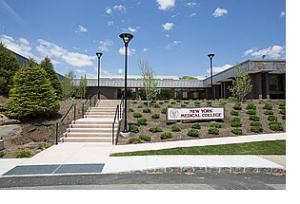

 The Clinical Skills and Simulation Center offers 21,000-square-feet of medical education opportunities for students, faculty, residents and other allied health professionals in the Hudson Valley. It is an informative and safe environment for medical students/medical professionals to learn, practice and repeat sophisticated medical and communication techniques to the point of mastery, while attaining automaticity in performing basic medical procedures. When at the Center, learners have access to a wide variety of simulation modalities by interacting with standardized patients (highly trained actors) in fully equipped exam rooms, engaging with high fidelity simulation mannequins to challenge and evaluate critical thinking and clinical decision-making skills, and utilizing more than 70 procedural task trainers to learn about specific medical techniques and physical exam maneuvers. Additionally, The Clinical Skills and Simulation Center has American Heart Association Training Center status which can provide BLS, ACLS, and PALs courses for students, faculty and community health providers.
The Clinical Skills and Simulation Center offers 21,000-square-feet of medical education opportunities for students, faculty, residents and other allied health professionals in the Hudson Valley. It is an informative and safe environment for medical students/medical professionals to learn, practice and repeat sophisticated medical and communication techniques to the point of mastery, while attaining automaticity in performing basic medical procedures. When at the Center, learners have access to a wide variety of simulation modalities by interacting with standardized patients (highly trained actors) in fully equipped exam rooms, engaging with high fidelity simulation mannequins to challenge and evaluate critical thinking and clinical decision-making skills, and utilizing more than 70 procedural task trainers to learn about specific medical techniques and physical exam maneuvers. Additionally, The Clinical Skills and Simulation Center has American Heart Association Training Center status which can provide BLS, ACLS, and PALs courses for students, faculty and community health providers.
As a model for “green” building design and construction, the Center sets an important precedent for development in the region. Ellenzweig Associates, Inc.; Lothrop Associates, LLP; and Whiting-Turner, Inc. developed designs for the Center that include renewable materials and energy-efficient systems. Awarded LEED Gold- certification level, the facility uses fewer resources compared to other buildings of similar size due to efficient lighting fixtures, low-flow toilets and sinks, reflective roofing and occupancy sensors that control lighting and temperature in empty rooms all bolster the Center’s efficiency. The water reduction inside parallels a water restoration system outdoors: The front patio is set with pervious paving, which allows rainwater to replenish the groundwater and reduces the effects of runoff on the local ecosystem. Construction material included largely recycled material with responsibly harvested finishes, and most of the debris was recycled in turn to divert waste from landfills. Low-VOC paints, adhesives and flooring contribute to a healthy indoor environment.